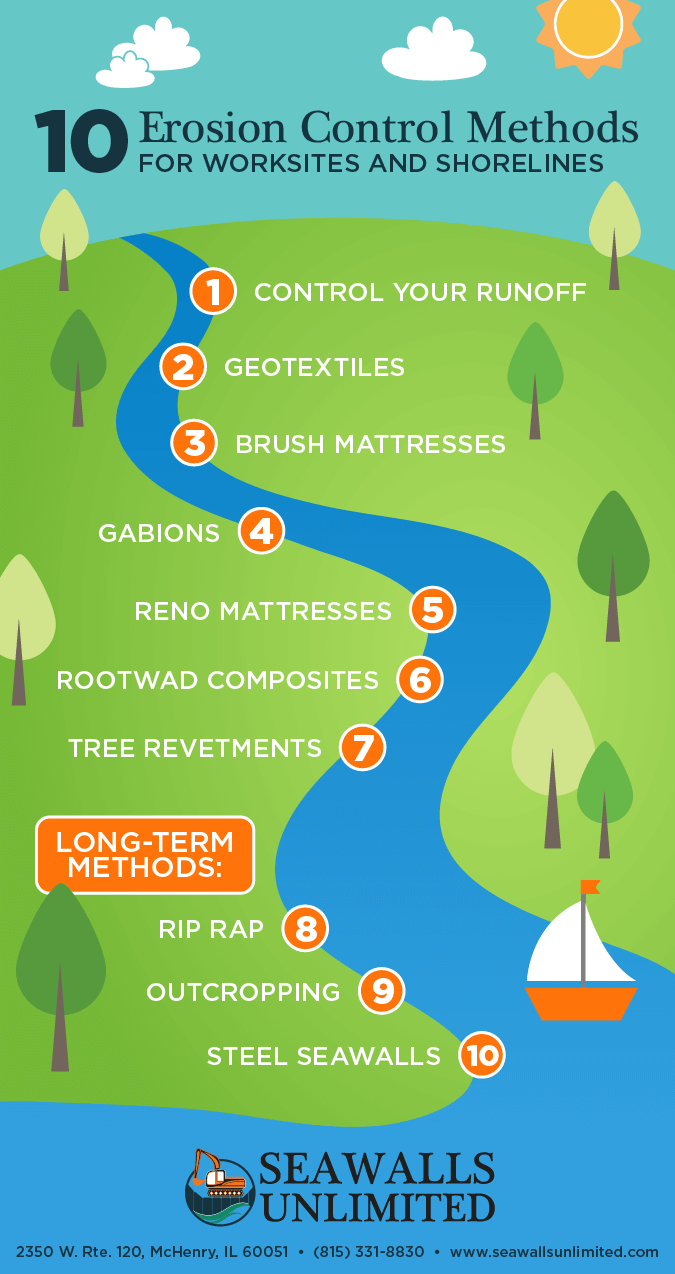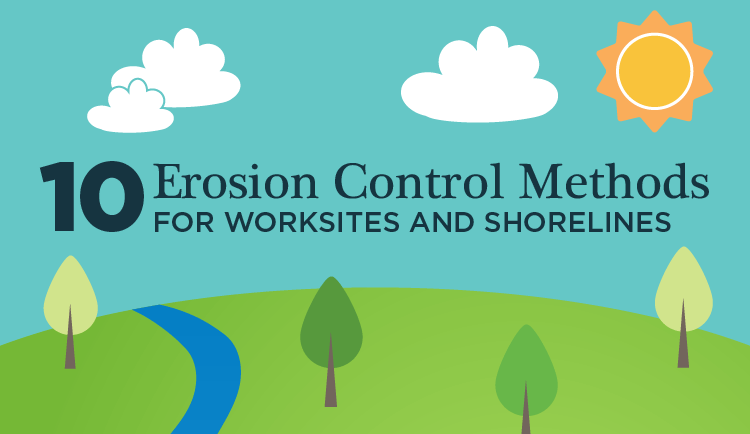Protect Your Worksite and the Environment with These Erosion Control Methods
When left unchecked, soil erosion can threaten the structural integrity of construction sites and restoration projects. Erosion caused by wind, rain, or runoff can also harm the environment and lead to costly fines from regulators.
For all these reasons, it’s crucial to use erosion control methods during construction and restoration projects.
But what are the best erosion control methods?
We’re glad you asked because, in this blog, we will list ten strategies you can use to keep erosion in check at your worksite. We hope you find them useful!
1. Control Runoff and Sediment
One of the most significant sources of erosion is the water runoff from a worksite. This water can dump sediment into clean waterways if not dealt with the right way.
To counter this problem, start by setting up a clean and secure perimeter around your site. You can do this by following these three steps:
- Create a temporary silt fence barrier trenched in the ground.
- Construct a sediment trap or ditch to redirect runoff. You can control the inflow by adding diversion ditches to the up-slope side of your construction site.
- If your site borders a clean body of water, install turbidity barriers or silt curtains. These barriers should consist of a geotextile membrane that floats on the water while the bottom stays anchored to the ground with weights.
By putting this secure perimeter in place, you will keep erosion to a minimum and sediment out of the waterways near your site.
How Long Do Different Kinds of Seawalls Last?
First, let’s take a look at the life expectancy of the three main types of seawalls: steel seawalls, outcropping, and rip rap.
Steel seawalls will typically last an average of 35 years. However, if galvanized, they will usually last a few years longer.
Outcropping and rip rap, since they consist of rock and stones, usually outlast their steel counterparts. Given the proper attention and maintenance, these seawalls should last a lifetime.
However, a seawall’s makeup isn’t the only factor determining its longevity.
2. Use Geotextiles for a Variety of Purposes
Geotextiles are an erosion control measure that almost every site should consider in some form. They’re eco-friendly, easy to install, and require relatively low maintenance.
Workers often use them to protect the underlying soil of retaining structures, embankments, pipelines, and roads.

Types of Geotextiles
We typically classify a geotextile according to the function it serves. It can serve any of the following purposes:
- Filtration
- Separation
- Drainage
- Sealing
- Reinforcement
The purpose a geotextile serves largely depends on whether it is woven or unwoven.
Woven geotextiles are open mesh structures with warp-knitted fibers. They work well underneath structures with high traffic or heavy objects, such as rip rap, driveways, roads, or railroads.
Non-woven geotextiles, on the other hand, have a closed, felt-like fabric surface, which allows water to flow through quickly. Because of this, they are ideal for filtration and drainage.
Both woven and unwoven geotextiles come in a variety of materials, including coconut fibers, straw, or synthetics.
Installing Geotextiles
Geotextiles typically come bound in a roll. One common application method is rolling them out over the surface of a riverbank to prevent erosion on a new slope.
You can sometimes also grow vegetation over the geotextile since the roots will interlock with the fibers. However, you shouldn’t do this on channels with lots of sediment because the sediment will settle in the geotextile and destroy the vegetation.
3. Protect Streams with Brush Mattresses
A brush mattress consists of branches anchored to the ground with stakes. These branches protect the bank by catching sediment during rainstorms. Because of their design, brush mattresses are ideal for perennial streams with ample sunlight.
When installing a brush mattress, you must place the system within the soil so that the mattress can absorb the water. You should also keep in mind that heavy rain can sometimes wash away the mattress material. When this happens, you should fix the mattress as soon as possible.
4. Build Gabions to Stabilize Slopes
Gabions are rectangular baskets of steel woven wire mesh. Workers install them by lacing them together and filling their compartments with stones or concrete rubble.
Some typical uses for gabions are channel linings, slope stabilization, and retaining walls. They typically work best in locations where there’s a bank of small rocks and a high probability of soil erosion.
5. Construct Reno Mattresses for Larger Worksites
A Reno Mattress is a particular type of gabion that is ideal for larger worksites because it can cover a wider surface area than a standard gabion.
Both Reno Mattresses and standard gabions are popular because they are easy to build, cost-effective, and require no added drainage.
However, they also have some weaknesses. For one thing, they aren’t the prettiest solutions. And you must also be extra careful with the footing in areas with unstable water flow and rapid erosion.
6. Lower Flow Speeds with Rootwad Composites
Rootwad composites are systems of interlocking tree materials, which perform two main functions. First, they stabilize streambanks by lowering flow speeds. Second, they provide habitats for aquatic wildlife.
The popularity of roodwad composites stems from the fact that they are cost-effective and environmentally friendly. However, they are also more complicated to install than other erosion control methods.
7. Use Tree Revetments to Slow the Current
A tree revetment involves anchoring trees along a streambank. The trees decrease erosion by slowing the current along the bank and trapping silt and sand.
This method is high maintenance, but cost-effective. It’s also great for establishing live river trees along the shore.
Before you build a tree revetment, you should check whether you need a permit from the U.S. Army Corps of Engineers. We would also recommend consulting this guide from the Missouri Department of Conservation to learn how to build them.

8-10. Block Erosion Long-Term with Rip Rap, Outcropping, or Steel Seawalls
Temporary erosion control measures are not always enough. You may also have to put longer-term fixes in place to protect the area from erosion. That’s where rip rap, outcropping, and steel seawalls come in.
Outcropping and rip rap are standard erosion control methods made from layers of interlocking stones. Outcropping typically consists of solid, flat, heavy rocks blasted out of limestone. Rip rap, on the other hand, consists of smaller stones layered together to give a more natural appearance.
Steel seawalls, on the other hand, are built into the ground along a shoreline. They offer solid protection from erosion caused by weather, excessive boat wakes, and more.
All of these erosion control methods look great and provide long-term protection for pond, river, and lake shorelines.
Call the Pros for Long-Term Erosion Control
Long-term erosion control solutions are major projects that are difficult to tackle on one’s own.
Seawalls Unlimited in McHenry, IL, has the experience and equipment to take on all kinds of erosion control projects. Give us a call at (815) 331-8830 to schedule a consultation!
Editor’s note: This blog was originally published on May 12, 2017 and was updated October 30, 2019.

